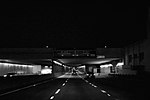Aviation/Century station
C Line (Los Angeles Metro)California railway station stubsFuture Los Angeles Metro Rail stationsK Line (Los Angeles Metro)Los Angeles County, California geography stubs ... and 5 more
Los Angeles Metro stubsRailway stations scheduled to open in 2024Use mdy dates from September 2023Westchester, Los AngelesWikipedia page with obscure subdivision

Aviation/Century station is an elevated light rail station on the C and K lines of the Los Angeles Metro Rail system. It is located alongside Aviation Boulevard above its intersection with Century Boulevard, located in the Westchester neighborhood of Los Angeles. Construction on the station is complete, but it is not expected to open until late 2024 due to construction on the LAX Automated People Mover and LAX/Metro Transit Center station.The Century railroad bridge was demolished on July 25, 2014, to make way for the station.
Excerpt from the Wikipedia article Aviation/Century station (License: CC BY-SA 3.0, Authors, Images).Aviation/Century station
West Century Boulevard, Los Angeles
Geographical coordinates (GPS) Address External links Nearby Places Show on map
Geographical coordinates (GPS)
| Latitude | Longitude |
|---|---|
| N 33.945598 ° | E -118.378573 ° |
Address
Aviation/Century
West Century Boulevard 5601
90045 Los Angeles
California, United States
Open on Google Maps









